It looks like you're using an Ad Blocker.
Please white-list or disable AboveTopSecret.com in your ad-blocking tool.
Thank you.
Some features of ATS will be disabled while you continue to use an ad-blocker.
6
share:
Some time ago I created a thread describing my theory of Negative Energy & Negative
Space. Since that time there have been some interesting developments which I thought were worth sharing. If you don't have time to read my
other thread, let me give a very brief summary of the idea: if the universe created an equal amount of negative and positive energy during the big
bang, then the universe could have come from nothing because it has zero total energy. Dark energy, the energy which causes the space between all
galaxies to expand, behaves exactly like negative energy would behave, because all energy has a mass associated with it, and anything with a negative
energy must also have a negative mass and therefore negative gravity, so if you fill space with lots of negative energy the negative gravity will
cause space to expand.
Mainstream science doesn't have an explanation for dark energy, they say it could be caused by vacuum fluctuations but the numbers simply don't add up. In this theory dark energy is exactly what it looks like: negative energy. We cannot actually see dark energy, but we know it must exist because the universe is undergoing metric expansion. In my other thread I propose an idea called negative space, and I say that negative energy (aka dark energy) must exist in this space and that's why we cannot detect it from our positive space. If you want more details on that idea then read the other thread, but the exact way it works isn't important for this thread, all that really matters is that we have an equal amount of positive matter and an equal amount of negative matter, and that they are unable to interact with each other, except via the force of gravity.
So now we have this basic framework set up we can ask how would the dispersion of negative energy look if we could actually see it. Well for a start we know what our positive matter universe looks like, because we just need to look out at the sky to see it. And what we see are huge clumps of matter separated by vast distances, because gravity pulls all the positive matter together. Since negative matter/energy has negative gravity, it should behave in the exact opposite way, meaning that negative matter is repelled from other negative matter and forms a gaseous cloud state of negative matter. Now I also mentioned that positive matter and negative matter can interact in only one way, via the force of gravity (the reasons for which are also explained in the other thread), so what will happen when we take everything into consideration?
Well my original theory predicted that the positive matter will still condense into clumps of larger matter, and that negative matter would still form a gas like state, but I also predicted that the positive matter wouldn't get too close to the negative matter, which would result in a cavity/void around the clumps of positive matter where there was no negative or positive matter. So the space between all galaxies is filled with the gas cloud of negative matter, but there are spherical cavities in the cloud where our positive matter galaxies are located. Now since negative matter has negative mass, removing negative matter is the equivalent of adding positive matter, so if you have a cavity of negative matter surrounding galaxies, it makes those galaxies look like they have more mass than they really do, explaining away dark matter.
Dark matter (not to be confused with dark energy) is the theoretical form of matter which we believe causes the mass of galaxies to be much higher than the amount of visible matter they seem to contain. We know they have a much higher mass because mass bends space-time and causes light to curve around large objects. The more massive the object, the more it bends. So we need dark matter to explain why light bends so much around galaxies which don't seem to have enough visible matter to account for their total mass measured by seeing how intensely light is curved when passing by the object. However this theory totally explains away dark matter and it does it in a very elegant and natural way. We simply say that dark matter is a gravitational illusion caused by a void of negative matter around our galaxy.
Taking this approach makes it possible to easily explain away many unsolved problems in science, but I never really had any mathematical model or simulation to prove it might possibly be right, well not until now. I recently created a macro-scale matter simulator to see how negative matter and positive matter would behave if put together and allowed to interact only via the force of gravity, and the results were quite amazing. Now as a programmer I always cringe when I hear scientists talking about how they simulated the evolution of the universe on their computers, because I understand the sheer computational complexity of the problem and I understand how even the smallest tweak in the algorithm can change everything. The truth is it takes a super computer even to calculate the behavior of a few small molecules using real world physics.
However, I'm only simulating things on the macro scale, meaning I'm looking at how large objects such as planets or galaxies interact, and at such large scales things like quantum mechanics and forces which act on elementary particles become virtually irrelevant and all I need to worry about is how the objects are gravitationally attracted to each other. In my simulation I simply used classical motion mechanics and the formula for calculating the gravitational attraction between two objects with some mass. In my simulation I start with an equal amount of positive matter and negative matter placed randomly, my goal was just to see how they behave and evolve when placed together so that I could prove my theory has merit, I wasn't trying to simulate the entire big bang process because it's just not a feasible task for a classical computer.
The following images show the result of my simulation, with positive matter in yellow and negative matter in blue. Keep in mind this is using only 1000 positive "particles" and 1000 negative "particles", and I haven't even tweaked variables like big G to make it behave the way I wanted. In fact the value of big G in these simulations shown below is still set to 1, but it already seems to work quite well.
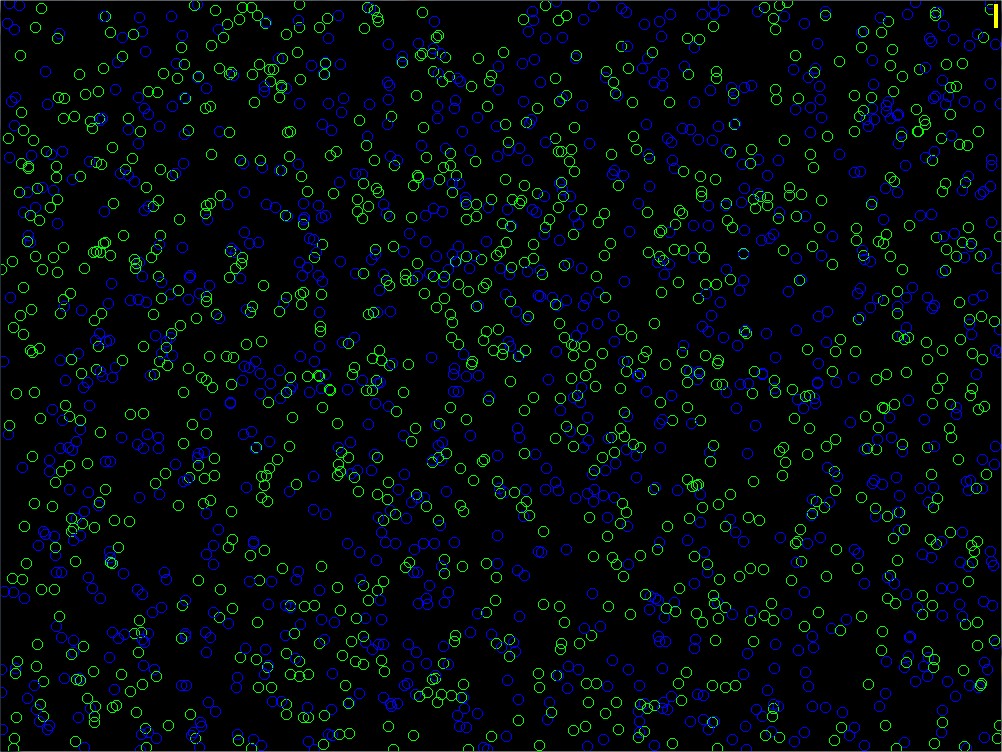
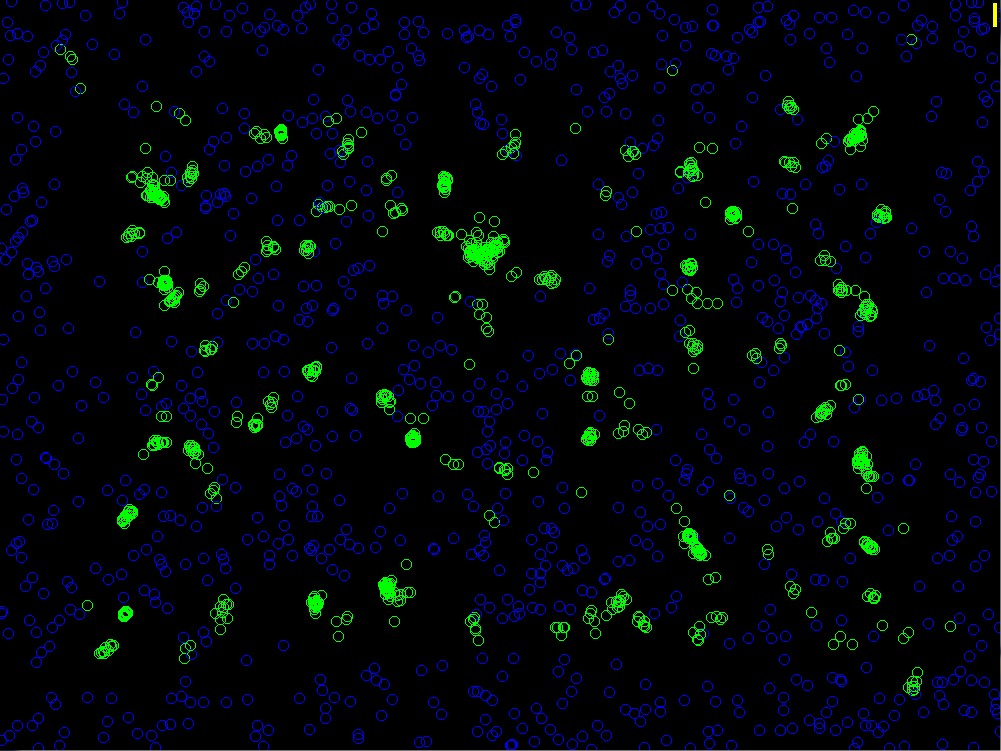
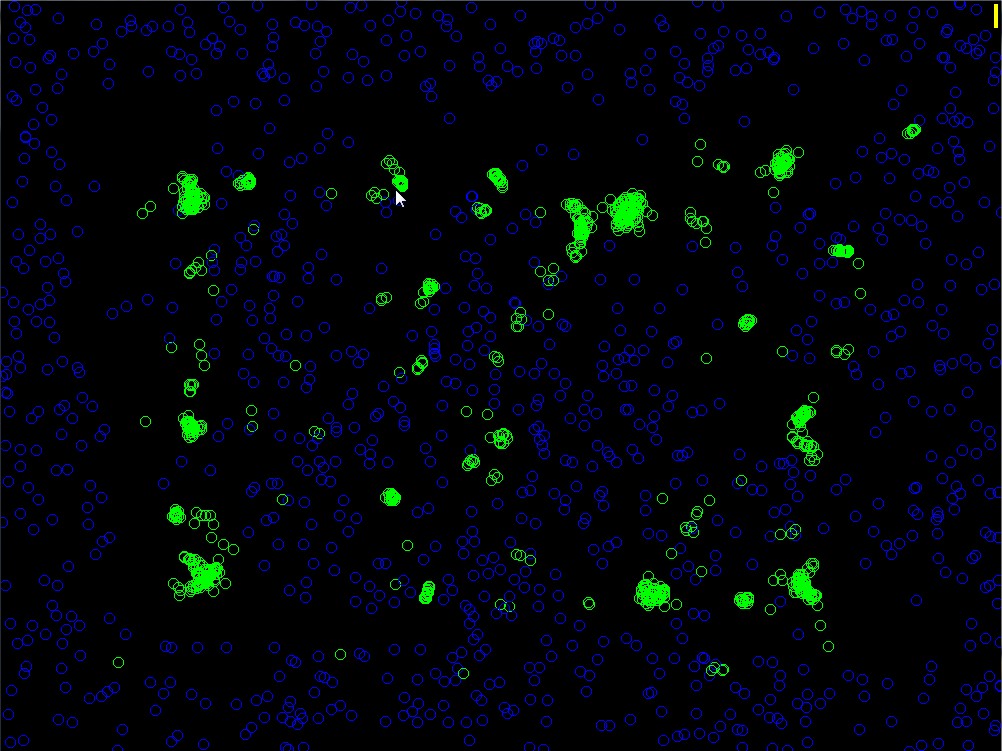
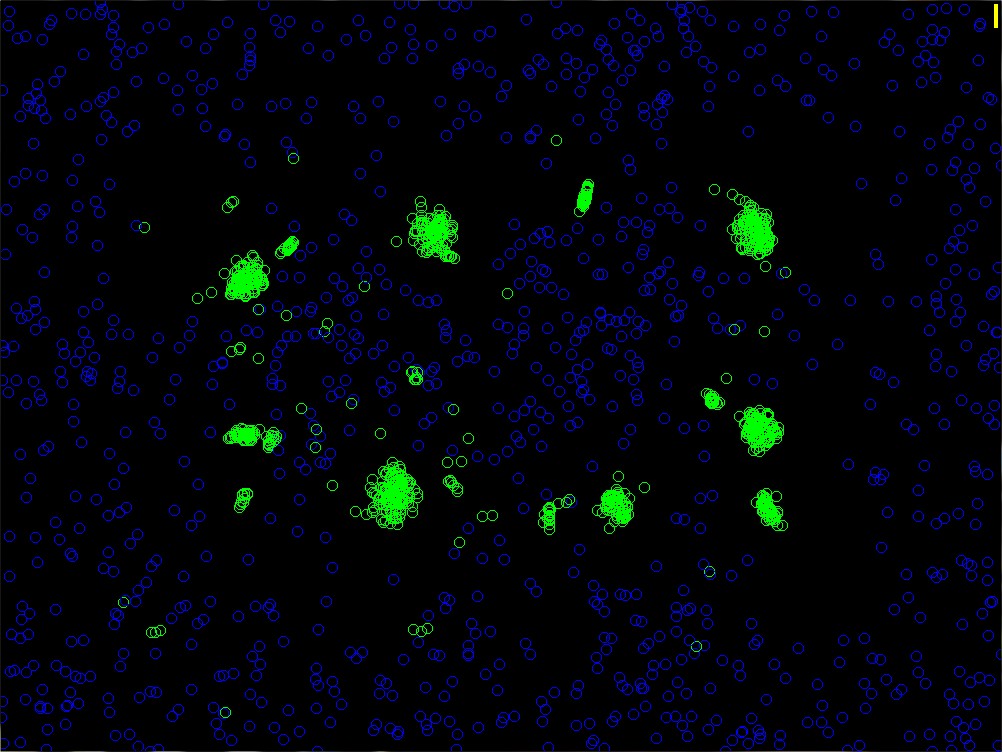
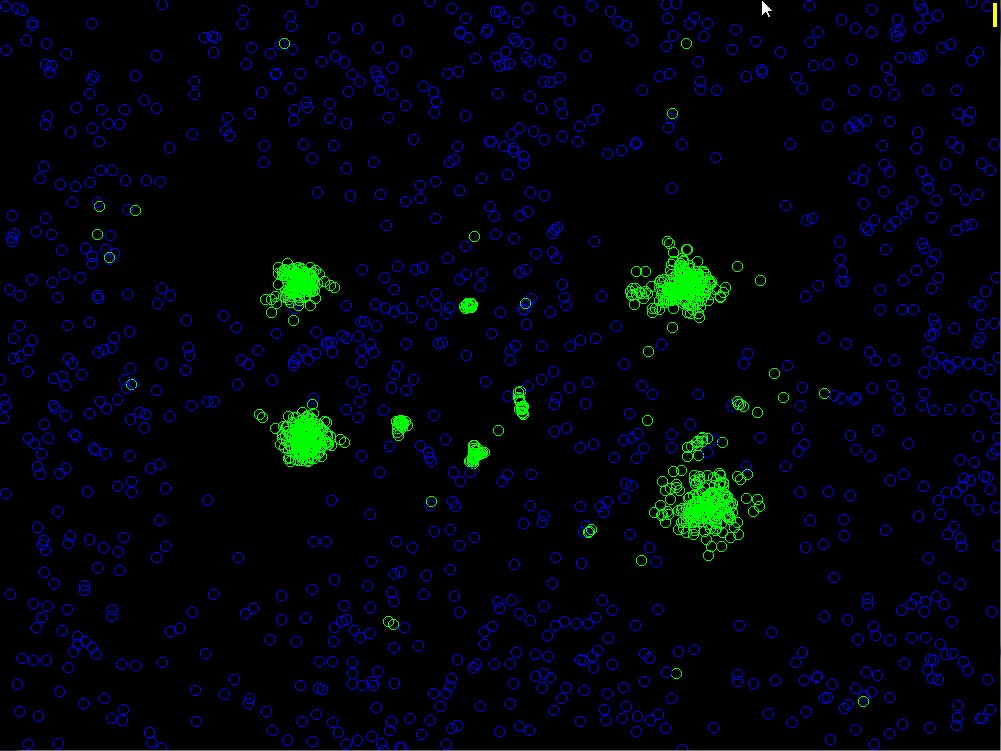
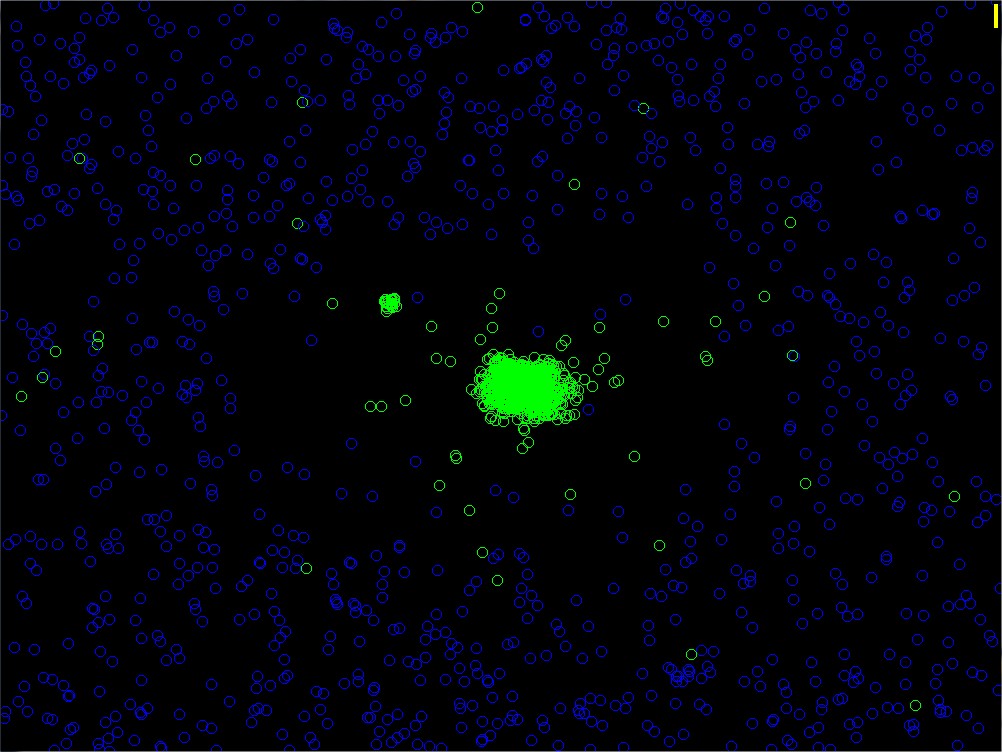
Mainstream science doesn't have an explanation for dark energy, they say it could be caused by vacuum fluctuations but the numbers simply don't add up. In this theory dark energy is exactly what it looks like: negative energy. We cannot actually see dark energy, but we know it must exist because the universe is undergoing metric expansion. In my other thread I propose an idea called negative space, and I say that negative energy (aka dark energy) must exist in this space and that's why we cannot detect it from our positive space. If you want more details on that idea then read the other thread, but the exact way it works isn't important for this thread, all that really matters is that we have an equal amount of positive matter and an equal amount of negative matter, and that they are unable to interact with each other, except via the force of gravity.
So now we have this basic framework set up we can ask how would the dispersion of negative energy look if we could actually see it. Well for a start we know what our positive matter universe looks like, because we just need to look out at the sky to see it. And what we see are huge clumps of matter separated by vast distances, because gravity pulls all the positive matter together. Since negative matter/energy has negative gravity, it should behave in the exact opposite way, meaning that negative matter is repelled from other negative matter and forms a gaseous cloud state of negative matter. Now I also mentioned that positive matter and negative matter can interact in only one way, via the force of gravity (the reasons for which are also explained in the other thread), so what will happen when we take everything into consideration?
Well my original theory predicted that the positive matter will still condense into clumps of larger matter, and that negative matter would still form a gas like state, but I also predicted that the positive matter wouldn't get too close to the negative matter, which would result in a cavity/void around the clumps of positive matter where there was no negative or positive matter. So the space between all galaxies is filled with the gas cloud of negative matter, but there are spherical cavities in the cloud where our positive matter galaxies are located. Now since negative matter has negative mass, removing negative matter is the equivalent of adding positive matter, so if you have a cavity of negative matter surrounding galaxies, it makes those galaxies look like they have more mass than they really do, explaining away dark matter.
Dark matter (not to be confused with dark energy) is the theoretical form of matter which we believe causes the mass of galaxies to be much higher than the amount of visible matter they seem to contain. We know they have a much higher mass because mass bends space-time and causes light to curve around large objects. The more massive the object, the more it bends. So we need dark matter to explain why light bends so much around galaxies which don't seem to have enough visible matter to account for their total mass measured by seeing how intensely light is curved when passing by the object. However this theory totally explains away dark matter and it does it in a very elegant and natural way. We simply say that dark matter is a gravitational illusion caused by a void of negative matter around our galaxy.
Taking this approach makes it possible to easily explain away many unsolved problems in science, but I never really had any mathematical model or simulation to prove it might possibly be right, well not until now. I recently created a macro-scale matter simulator to see how negative matter and positive matter would behave if put together and allowed to interact only via the force of gravity, and the results were quite amazing. Now as a programmer I always cringe when I hear scientists talking about how they simulated the evolution of the universe on their computers, because I understand the sheer computational complexity of the problem and I understand how even the smallest tweak in the algorithm can change everything. The truth is it takes a super computer even to calculate the behavior of a few small molecules using real world physics.
However, I'm only simulating things on the macro scale, meaning I'm looking at how large objects such as planets or galaxies interact, and at such large scales things like quantum mechanics and forces which act on elementary particles become virtually irrelevant and all I need to worry about is how the objects are gravitationally attracted to each other. In my simulation I simply used classical motion mechanics and the formula for calculating the gravitational attraction between two objects with some mass. In my simulation I start with an equal amount of positive matter and negative matter placed randomly, my goal was just to see how they behave and evolve when placed together so that I could prove my theory has merit, I wasn't trying to simulate the entire big bang process because it's just not a feasible task for a classical computer.
The following images show the result of my simulation, with positive matter in yellow and negative matter in blue. Keep in mind this is using only 1000 positive "particles" and 1000 negative "particles", and I haven't even tweaked variables like big G to make it behave the way I wanted. In fact the value of big G in these simulations shown below is still set to 1, but it already seems to work quite well.






Now looking at those images it's clear to see how the positive matter clumps together as expected, and how the negative matter stays in a gaseous
state. Most importantly however, we can clearly see cavities or voids forming around the clumps of positive matter just as predicted. However I must
admit that I did cheat in one small way to make it behave the way I wanted. I mentioned earlier that I used the same equations to calculate the force
between a positive particle and another positive particle or the force between a negative particle and another negative particle, but to calculate the
force between a positive particle and a negative particle I had to flip the sign of the result, meaning I would make the force negative if it was
positive, and positive if it was negative, but there's a good reason for this and I think it can be justified.
If I just use the same equation without flipping the sign, then positive matter is repelled from negative matter but negative matter is attracted to positive matter, and that makes it difficult for the cavities to form around the clumps of positive matter. However if I flip the sign of the result then the positive matter is attracted to the negative matter but the negative matter is repelled away from positive matter, causing the negative matter to stay away from large clumps of positive matter and thus create the cavities I was hoping for. Now the reason I think this can be justified is because we have no knowledge of how positive matter would interact with negative matter and there is already debate over whether the direction of the forces should be flipped or not, so the change I made is something already predicted by some scientists.
To me this was less of a cheat and more of a hint about the way gravity works. Another reason I think my change can be justified is because it's a very natural change which isn't unexpected at all. I mean it's not strange that when dealing with two different types of masses that you would have to flip the sign of the result. The final reason I think it can be justified is because everything has fit together way too perfectly for it to be a mistake, using this theory it's possible to explain at least half a dozen major unsolved problems in cosmology and my initial predictions match very well with my simulation. To get an idea of how well the results match my predictions, take a look at this image I hand-made in photoshop many months before creating my simulation program:
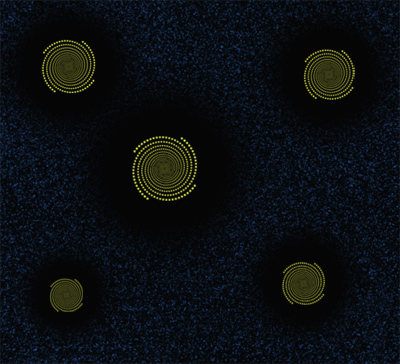
I know this is already quite a long opening post but now I want to spend a few moments looking at recent developments in the field of dark matter and how they lend credence to this theory. One piece of recent news in this field is related to dark matter halos (clumps of dark matter) which don't have a galaxy attached to them. Simulations suggest that our universe should be full of these structures.
The problem is these types of structures don't seem to exist in nature. Some argue that we simply haven't looked hard enough or that our equipment simply isn't sensitive enough to detect them, but they also make the same arguments about dark matter particle detectors, which have been running for many years and haven't detected anything yet. At some point we have to admit nothing is there to detect.
The theory I have proposed can easily explain why these types of structures don't exist in nature, because dark matter particles don't really exist, they are a gravitational illusion caused by a cavity of negative matter around our galaxy, and as such you will only see "dark matter halos" around galaxies, you wont ever see a dark matter halo without a galaxy, unless they've become dislodged an in impact with another galaxy.
On that note, there was some news released in 2012 concerning the weird behavior of dark matter halos in galactic collision events. This model may also be able to help explain these events which cannot be easily explained by the standard dark matter theories:
If we stop thinking of dark matter as actual particles with a mass, and instead conceptualize the effect of dark matter as a gravitational illusion caused by a cavity of negative matter in and around our galaxy, it becomes much more plausible and easier to understand how the supposed dark matter could separate from the galaxies they are attached to; what is really happening is that the cavities are becoming dislocated from their parent galaxy, and this can happen rather easily because the galaxy only stays at the center of the cavity via a gravitational balancing act.
Based on these assumptions we can make the following prediction: if a cavity were to become completely dislodged from the galaxy it would shrink and disappear, and a new cavity should eventually form around the galaxy as it repels the negative matter around it. However this process may take too long to directly observe in real time, but such an observation would lend a lot of credibility to the proposed model. This also helps explain why the dark matter cores appear to pass through each other undisturbed, because what we really have are two cavities passing through each other.
If I just use the same equation without flipping the sign, then positive matter is repelled from negative matter but negative matter is attracted to positive matter, and that makes it difficult for the cavities to form around the clumps of positive matter. However if I flip the sign of the result then the positive matter is attracted to the negative matter but the negative matter is repelled away from positive matter, causing the negative matter to stay away from large clumps of positive matter and thus create the cavities I was hoping for. Now the reason I think this can be justified is because we have no knowledge of how positive matter would interact with negative matter and there is already debate over whether the direction of the forces should be flipped or not, so the change I made is something already predicted by some scientists.
To me this was less of a cheat and more of a hint about the way gravity works. Another reason I think my change can be justified is because it's a very natural change which isn't unexpected at all. I mean it's not strange that when dealing with two different types of masses that you would have to flip the sign of the result. The final reason I think it can be justified is because everything has fit together way too perfectly for it to be a mistake, using this theory it's possible to explain at least half a dozen major unsolved problems in cosmology and my initial predictions match very well with my simulation. To get an idea of how well the results match my predictions, take a look at this image I hand-made in photoshop many months before creating my simulation program:

I know this is already quite a long opening post but now I want to spend a few moments looking at recent developments in the field of dark matter and how they lend credence to this theory. One piece of recent news in this field is related to dark matter halos (clumps of dark matter) which don't have a galaxy attached to them. Simulations suggest that our universe should be full of these structures.
"Thanks to our simulations we know that if our theories of dark matter are correct then the Universe around us should be full of halos that failed to make a galaxy. Perhaps astronomers will one day figure out a way to find them."
phys.org...
The problem is these types of structures don't seem to exist in nature. Some argue that we simply haven't looked hard enough or that our equipment simply isn't sensitive enough to detect them, but they also make the same arguments about dark matter particle detectors, which have been running for many years and haven't detected anything yet. At some point we have to admit nothing is there to detect.
The theory I have proposed can easily explain why these types of structures don't exist in nature, because dark matter particles don't really exist, they are a gravitational illusion caused by a cavity of negative matter around our galaxy, and as such you will only see "dark matter halos" around galaxies, you wont ever see a dark matter halo without a galaxy, unless they've become dislodged an in impact with another galaxy.
On that note, there was some news released in 2012 concerning the weird behavior of dark matter halos in galactic collision events. This model may also be able to help explain these events which cannot be easily explained by the standard dark matter theories:
It was the result no one wanted to believe. Astronomers observed what appeared to be a clump of dark matter left behind during a bizarre wreck between massive clusters of galaxies.
The dark matter collected into a "dark core" containing far fewer galaxies than would be expected if the dark matter and galaxies hung together. Most of the galaxies apparently have sailed far away from the collision. This result could present a challenge to basic theories of dark matter, which predict that galaxies should be anchored to the invisible substance, even during the shock of a collision.
hubblesite.org...
If we stop thinking of dark matter as actual particles with a mass, and instead conceptualize the effect of dark matter as a gravitational illusion caused by a cavity of negative matter in and around our galaxy, it becomes much more plausible and easier to understand how the supposed dark matter could separate from the galaxies they are attached to; what is really happening is that the cavities are becoming dislocated from their parent galaxy, and this can happen rather easily because the galaxy only stays at the center of the cavity via a gravitational balancing act.
Based on these assumptions we can make the following prediction: if a cavity were to become completely dislodged from the galaxy it would shrink and disappear, and a new cavity should eventually form around the galaxy as it repels the negative matter around it. However this process may take too long to directly observe in real time, but such an observation would lend a lot of credibility to the proposed model. This also helps explain why the dark matter cores appear to pass through each other undisturbed, because what we really have are two cavities passing through each other.
85% of the universe is black energy and matter not half and half.
if it was half and half WAY more physical mass would take up the space.
What are these pictures anyways?
And you have it wrong, Black matter and energy is not negative it is Neutral. Just like the Neutron is Neutral, the positron is positive and the negative is electrons.
When the positive and negative meet together it creation attraction.
An atom is made of neutrons, Protons, and electrons.
If electrons are the negative force, Then how can black matter and energy be the negative force when the negative force already exists?
You need to to also mention Entropy. Because if there was a big bang, Then Entropy would eventually devour the entire universe into nothing.
Therefore blackholes must be something entirely different.
It is more likely they are the result of an constant implosion. But judging by the size and stabability of black holes. They cannot solely rely on absorbing stars and asteroids.
So they must be feeding on decaying matter, SInce the universe would be full of it.
If this is the case it means black matter and energy is generated by high compression.
How is this possible? Imagine a billion nukes being detonated, but their expansion being drained into a funnel instead of fully expansing, the reaction is ripped apart and shattered atom by atom.
There is no parallell universe for this mass to spill to so it is shot out either side of the vortex along with highly unstable residual energy from the annihlation of particles. The vortex funnels this energy out either side which forms a bubble around our galaxy in the form of massive gammaray jet streams.
Just how i understand it. Mass is like a motor, and when you remove the components such as the the ability for electrons to orbit, then no *hologram* is generated by the spinning. And so appears to not exist.
The idea would be that there is a ration of 9 to 1 black energy/mass to physical mass.
That way compressed mass that has been sitting around for aeons can re-expand into physical mass again after laying in a dorment state. By holding the shards of these particles still for an exceedingly long time it recharges decayed mass. Otherwise the universe would burn out. Many things can explain why some of the universe seems so old and some of it seems brand new. Is because this process can occure for eternity. So the milkyway may be new, Hell even nearby galaxies could of already died and been reborn again several times. Even our own, we wouldn't know and couldn't' find out unless we escaped our galaxy and observed it from a newly formed one.
Just my take on all this. Black matter contradicts the big bang. And actually makes it obsolete.
if it was half and half WAY more physical mass would take up the space.
What are these pictures anyways?
And you have it wrong, Black matter and energy is not negative it is Neutral. Just like the Neutron is Neutral, the positron is positive and the negative is electrons.
When the positive and negative meet together it creation attraction.
An atom is made of neutrons, Protons, and electrons.
If electrons are the negative force, Then how can black matter and energy be the negative force when the negative force already exists?
You need to to also mention Entropy. Because if there was a big bang, Then Entropy would eventually devour the entire universe into nothing.
Therefore blackholes must be something entirely different.
It is more likely they are the result of an constant implosion. But judging by the size and stabability of black holes. They cannot solely rely on absorbing stars and asteroids.
So they must be feeding on decaying matter, SInce the universe would be full of it.
If this is the case it means black matter and energy is generated by high compression.
How is this possible? Imagine a billion nukes being detonated, but their expansion being drained into a funnel instead of fully expansing, the reaction is ripped apart and shattered atom by atom.
There is no parallell universe for this mass to spill to so it is shot out either side of the vortex along with highly unstable residual energy from the annihlation of particles. The vortex funnels this energy out either side which forms a bubble around our galaxy in the form of massive gammaray jet streams.
Just how i understand it. Mass is like a motor, and when you remove the components such as the the ability for electrons to orbit, then no *hologram* is generated by the spinning. And so appears to not exist.
The idea would be that there is a ration of 9 to 1 black energy/mass to physical mass.
That way compressed mass that has been sitting around for aeons can re-expand into physical mass again after laying in a dorment state. By holding the shards of these particles still for an exceedingly long time it recharges decayed mass. Otherwise the universe would burn out. Many things can explain why some of the universe seems so old and some of it seems brand new. Is because this process can occure for eternity. So the milkyway may be new, Hell even nearby galaxies could of already died and been reborn again several times. Even our own, we wouldn't know and couldn't' find out unless we escaped our galaxy and observed it from a newly formed one.
Just my take on all this. Black matter contradicts the big bang. And actually makes it obsolete.
a reply to: AnuTyr
That is just a guess based on our current theories of dark energy and dark matter, there is good evidence to suggest that dark energy makes up 50% of the energy in the universe:
If the density of dark energy is exactly the same as the density of normal matter what does that tell us? It tells us that negative matter and positive matter were created in equal amounts. It is certainly no coincidence that the densities match, they have always matched and will always continue to match.
*sigh* if you're going to try to act smart at least use correct scientific terms, and at least try to understand what I'm talking about before you comment. I'm not talking about negative charges, I'm talking about objects with negative mass, an exotic form of matter which is not known to exist by mainstream science, but I predict it must exist in order for the universe to appear from nothing. The only universe which can spontaneously arise from nothing is a universe with zero total energy. Some scientists will argue that the gravity of normal matter holds the negative energy needed for the universe to have zero total energy, but there are far too many problems with that idea for me to buy into it.
85% of the universe is black energy and matter not half and half.
That is just a guess based on our current theories of dark energy and dark matter, there is good evidence to suggest that dark energy makes up 50% of the energy in the universe:
Why is the energy density of the dark energy component of the same magnitude as the density of matter at present when the two evolve quite differently over time; could it be simply that we are observing at exactly the right time?
List of unsolved problems in physics
If the density of dark energy is exactly the same as the density of normal matter what does that tell us? It tells us that negative matter and positive matter were created in equal amounts. It is certainly no coincidence that the densities match, they have always matched and will always continue to match.
And you have it wrong, Black matter and energy is not negative it is Neutral. Just like the Neutron is Neutral, the positron is positive and the negative is electrons.
*sigh* if you're going to try to act smart at least use correct scientific terms, and at least try to understand what I'm talking about before you comment. I'm not talking about negative charges, I'm talking about objects with negative mass, an exotic form of matter which is not known to exist by mainstream science, but I predict it must exist in order for the universe to appear from nothing. The only universe which can spontaneously arise from nothing is a universe with zero total energy. Some scientists will argue that the gravity of normal matter holds the negative energy needed for the universe to have zero total energy, but there are far too many problems with that idea for me to buy into it.
edit on 11/9/2014 by ChaoticOrder because: (no reason given)
Ok I tried tweaking a few variables to see if I could make it work it work even better and I got some good results. I changed the value of big G to
what it's supposed to be and assigned each particle a random mass so they weren't all the same. After letting the simulation run for a few minutes I
get the following result. Again the particles with a negative mass are shown in blue and the ones with a positive mass are shown in yellow.
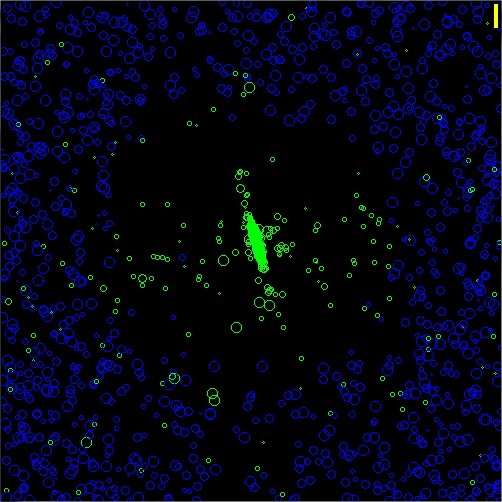
With some labels applied:
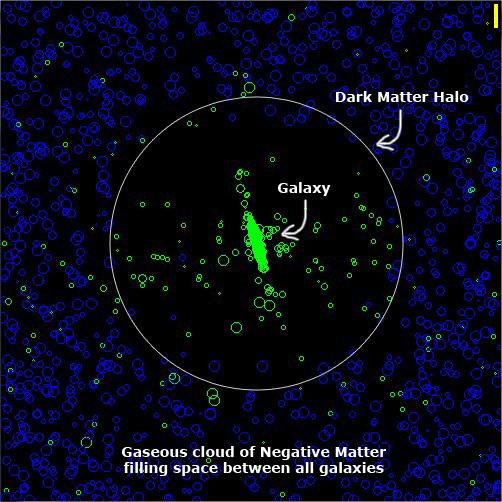
Now it's important to realize that the blue negative matter (aka dark energy) is not actually visible to us for reasons I mentioned earlier. But this is what it would look like if it does exist and we could see it. It's also important to realize why the cavity around the galaxy would make it appear to have more mass. As we can see, most of the space is filled with negative matter, so there's a differential inside the cavities where less negative matter exists, and that differential intensifies the lensing effect of a galaxy surrounded by a dark halo, which creates a gravitational illusion and makes us think the galaxy must be engulfed in this mysterious dark matter.
Here is another major unsolved problem in physics which this theory easily solves:
So basically they are completely stumped about why dark matter doesn't condense near the center of the galaxy, or more generally, why it doesn't seem to condense at all, yet it must gravitationally interact with other particles for their theories to work. Now I don't think I even need to explain how my theory can solve this huge issue with the standard model of dark matter because if you understand what I just explained a moment ago it's obvious: there is no dark matter, only a cavity of negative matter surrounding our galaxy, and it has virtually the same density throughout the entire cavity, until you get near the edges of the cavity.

With some labels applied:

Now it's important to realize that the blue negative matter (aka dark energy) is not actually visible to us for reasons I mentioned earlier. But this is what it would look like if it does exist and we could see it. It's also important to realize why the cavity around the galaxy would make it appear to have more mass. As we can see, most of the space is filled with negative matter, so there's a differential inside the cavities where less negative matter exists, and that differential intensifies the lensing effect of a galaxy surrounded by a dark halo, which creates a gravitational illusion and makes us think the galaxy must be engulfed in this mysterious dark matter.
Here is another major unsolved problem in physics which this theory easily solves:
The cuspy halo problem arises from cosmological simulations that seem to indicate cold dark matter (CDM) would form cuspy distributions — that is, increasing sharply to a high value at a central point — in the most dense areas of the universe. This would imply that the center of our galaxy, for example, should exhibit a higher dark-matter density than other areas. However, it seems rather that the centers of these galaxies likely have no cusp in the dark-matter distribution at all.
This remains an intractable problem. Speculation that the distribution of baryonic matter may somehow displace cold dark matter in the dense cores of spiral galaxies has not been substantiated by any plausible explanation or computer simulation.
Cuspy halo problem - Wikipedia
So basically they are completely stumped about why dark matter doesn't condense near the center of the galaxy, or more generally, why it doesn't seem to condense at all, yet it must gravitationally interact with other particles for their theories to work. Now I don't think I even need to explain how my theory can solve this huge issue with the standard model of dark matter because if you understand what I just explained a moment ago it's obvious: there is no dark matter, only a cavity of negative matter surrounding our galaxy, and it has virtually the same density throughout the entire cavity, until you get near the edges of the cavity.
edit on 12/9/2014 by ChaoticOrder because: (no reason given)
new topics
-
Those Great Fresh Pet Commercials
Television: 30 minutes ago -
S.C. Jack Smith's Final Report Says Trump Leads a Major Conspiratorial Criminal Organization!.
Political Conspiracies: 2 hours ago -
Advice for any young Adult .
General Chit Chat: 3 hours ago -
Joe meant what he said about Hunter's pardon....
US Political Madness: 4 hours ago -
Regent Street in #London has been evacuated due to a “bomb threat.”
Other Current Events: 4 hours ago -
It’s Falling…
Philosophy and Metaphysics: 6 hours ago -
Steering the Titantic from the Drydock.
Rant: 9 hours ago
top topics
-
Steering the Titantic from the Drydock.
Rant: 9 hours ago, 10 flags -
Joe meant what he said about Hunter's pardon....
US Political Madness: 4 hours ago, 9 flags -
Advice for any young Adult .
General Chit Chat: 3 hours ago, 6 flags -
S.C. Jack Smith's Final Report Says Trump Leads a Major Conspiratorial Criminal Organization!.
Political Conspiracies: 2 hours ago, 6 flags -
It’s Falling…
Philosophy and Metaphysics: 6 hours ago, 4 flags -
Regent Street in #London has been evacuated due to a “bomb threat.”
Other Current Events: 4 hours ago, 3 flags -
Those Great Fresh Pet Commercials
Television: 30 minutes ago, 2 flags
6
